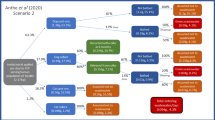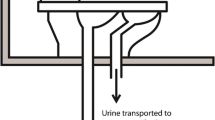Abstract
In 2020, Anthe et al. published a newly developed model to predict imidacloprid surface water concentrations stemming from sewage treatment plant (STP) effluent as a consequence of the use of veterinary medicinal products containing imidacloprid in the UK (Anthe in Environ Sci Eur (2020) 32:147, https://doi.org/10.1186/s12302-020–00424-4). The modelled data indicate that these veterinary medicinal products make only a very small contribution to the levels of Imidacloprid observed in the UK water monitoring programme.
The commentary by Perkins et al. (Perkins in Environ Sci Eur (2021) 33:88, https://doi.org/10.1186/s12302-021-00533-8) questioned the validity and conclusions of the modelling approach. We believe the modelling approach, which considered what we anticipated to be, the major exposure pathways, gives a realistic picture of the chronic emission via STPs to UK rivers.
Similar content being viewed by others
Background
Imidacloprid is an active ingredient included in plant protection, biocidal and veterinary medicinal products (VMPs). Monitoring data collected under the Water Framework Directive between 2016 and 2018 showed detectable and varying levels of Imidacloprid in the UK surface water bodies. Anthe et al. [1] investigated the potential contribution of VMPs by developing a model to predict the emissions from sewage treatment plants from the use of dog and cat spot-on and collar VMPs. Due to the absence of appropriate exposure models for VMPs, the model was built based on the principles of environmental exposure assessment for biocidal products under the biocidal product regulation (BPR). Three emission paths were considered to be the most likely routes for repeated emissions to waterways from the use of spot-on and collar VMPs, i.e. transfer to pet bedding followed by washing, washing/bathing of dogs, and walking dogs in the rain. Realistic worst-case input parameters were deduced from: product characteristics, sales and survey data. In addition, some of the input parameters came from data generated in experimental studies; the data from which has been evaluated by veterinary regulatory bodies as part of their approval of the authorisation of these VMPs. The calculated concentrations for each emission pathway did not exceed the ecological thresholds for the most sensitive aquatic invertebrate organisms and were found to be much lower than the UK monitoring data for river water.
A response from the authors to the critique by Perkins et al. [2] is provided below.
Comments
We welcome the views of others and take these seriously in reviewing our own work.
Perkins et al. [2] seem to question the validity of the well-established biocide modelling approach that is set out by the Authorities responsible for regulating biocides in the EU (such as the use of default values) [3]. The model is based on the principles of the environmental risk assessment for Biocidal Products, which provide protection over an extended period (e.g. biocidal insect repellents [5]). The default values accepted and widely used in biocide modelling and in our model are summarised in Table 1.
The model is designed to estimate the average contribution of Imidacloprid arriving in STPs due to its usage as a veterinary parasiticide in the catchment area of the STP. It gives an average concentration in the STP outflow and based on standard dilution factors [3] the subsequent predicted average concentrations of Imidacloprid in the rivers which are connected to the STP are calculated.
Focusing on the spot-on products, this calculated average concentration takes into account the seasonality effect by studying the months when most of the spot-ons are used. The resulting average river concentration for a month of highest use has been compared with the lowest Predicted No Effect Concentration (PNEC) for aquatic chronic exposure in use by the European Commission, as well as the annual average surface water concentrations measured at different locations in the UK. The critique from Perkins et al. [2] stipulating that the model implies Imidacloprid is released from pets into the environment for 24 h only, is incorrect. The calculations are detailed in the section “Materials and Methods—Emission calculations” [1] with an example calculation given by the authors in the Additional File 1 (https://enveurope.springeropen.com/articles/10.1186/s12302-020-00424-4#additional-information). In the model, it is assumed that the applied amount of imidacloprid is available for 4 weeks, which is the period of protection registered on the label of the spot-ons. The average amount of Imidacloprid available per day equals the total amount applied in the month divided by 30. The total amount applied per month is calculated from the month of highest frequency of use, which is August based on survey data, as a fraction of the annual amount of imidacloprid used in the STP catchment area (see Eq. 4 [1]). Again, it is the daily average the model calculated to compare this with the chronic PNECs. There might be days with higher release and some with lower release, but it is reasonable to use the mean for comparison with the long-term chronic benchmark.
Another critique from Perkins et al. concerning unpublished in-house studies is not justified. A summary of the study design, main results and derived input parameter for the three emission scenarios were already provided in the Additional File 1 (https://enveurope.springeropen.com/articles/10.1186/s12302-020-00424-4#additional-information). An overview of the used in-house studies is provided in Table 2.
In the absence of regulatory guidance on the conduct of such studies, they were designed in-house to be realistic. The results were used to derive realistic input parameters for the model. Where appropriate the results of the pet owners’ survey have been used to support the derived parameters and a margin of safety has been considered for these input parameters as illustrated above in Table 2.
Perkins et al. dismiss, without any validation, other potential sources of imidacloprid found in UK rivers [2]. We believe that most of the arguments in the Perkins et al. commentary relates to exposure pathways without a consideration of their plausibility, relevance or significance. However, we acknowledge that amongst the criticism there is one which is fair and warrants further work: consideration of two additional potential pathways of imidacloprid into water. The build of the model was the first time this has ever been done for veterinary medicines and it is not surprising that enhancements can be considered. Before the commentary was published, we had already examined other potential exposure pathways and identified two additional major ones; hand washing after pet stroking and washing of clothes. We completed modelling of these pathways using the same calculation approach as described in the publication by Anthe et al. However, these results have not been published yet.
Conclusions
We are still convinced that the model gives reliable information on the most likely imidacloprid emissions from UK sewage treatment plants resulting from spot-ons and collars used for pets.
Further evidence is needed to establish the main contributors to detection of imidacloprid at certain points in UK waters. Modelling is one important source of evidence.
Availability of data and materials
The datasets used and analysed during the current study are available from the corresponding author on reasonable request.
Abbreviations
- BPR:
-
Biocidal products regulation
- EQS:
-
Environmental Quality Standard
- EU:
-
European Union
- STP:
-
Sewage treatment plant
- UK:
-
United Kingdom
- VMP:
-
Veterinary medicinal product
References
Anthe M et al (2020) Development of an aquatic exposure assessment model for imidacloprid in sewage treatment plant discharges arising from use of veterinary medicinal products. Environ Sci Eur 32:147. https://doi.org/10.1186/s12302-020-00424-4
Perkins R et al (2021) Dead in water: comment on “Development of an aquatic exposure assessment model for imidacloprid in sewage treatment plant discharges arising from use of veterinary medicinal products.” Environ Sci Eur 33:88. https://doi.org/10.1186/s12302-021-00533-8
ECHA (European Chemicals Agency) (2017) Guidance on biocidal products regulation: volume IV environment—assessment and evaluation (Parts B+C). European Chemicals Agency, Helsinki
OECD (Organisation for Economic Cooperation and Development) (2014) Insecticides, acaricides and products to control other arthropods for household and professional uses. Series on emission scenario documents, No. 18. OECD Publishing, Paris. https://doi.org/10.1787/9789264221123-en
ECHA (European Chemicals Agency) (2015) Emission scenario document for product type 19—repellents and attractants. European Chemicals Agency, Helsinki
Acknowledgements
Not applicable.
Funding
The project was funded by Bayer Animal Health GmbH.
Author information
Authors and Affiliations
Contributions
All authors reviewed the manuscript before submission. All authors read and approved the final manuscript.
Corresponding author
Ethics declarations
Ethics approval and consent to participate
Not applicable.
Consent for publication
Not applicable.
Competing interests
J. Achtenhagen works as consultant for Bayer Animal Health GmbH.
Additional information
Publisher's Note
Springer Nature remains neutral with regard to jurisdictional claims in published maps and institutional affiliations.
Rights and permissions
Open Access This article is licensed under a Creative Commons Attribution 4.0 International License, which permits use, sharing, adaptation, distribution and reproduction in any medium or format, as long as you give appropriate credit to the original author(s) and the source, provide a link to the Creative Commons licence, and indicate if changes were made. The images or other third party material in this article are included in the article's Creative Commons licence, unless indicated otherwise in a credit line to the material. If material is not included in the article's Creative Commons licence and your intended use is not permitted by statutory regulation or exceeds the permitted use, you will need to obtain permission directly from the copyright holder. To view a copy of this licence, visit http://creativecommons.org/licenses/by/4.0/.
About this article
Cite this article
Valles-Ebeling, B., Achtenhagen, J., Atkinson, J. et al. Authors’ response on Perkins et al. (2021) “Dead in the water: comment on “Development of an aquatic exposure assessment model for imidacloprid in sewage treatment plant discharges arising from use of veterinary medicinal products”. Environ Sci Eur 33, 138 (2021). https://doi.org/10.1186/s12302-021-00580-1
Received:
Accepted:
Published:
DOI: https://doi.org/10.1186/s12302-021-00580-1




